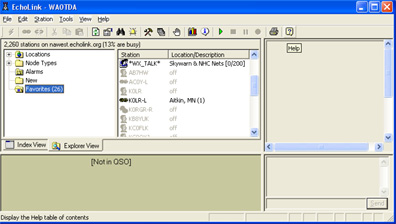Welcome to Handiham World!
Are you on Twitter? WA0TDA is.
 Twitter is a social networking site of sorts, with people sending short messages called "tweets" to anyone who cares to "follow" a particular user. This is sometimes called "micro-blogging".
Twitter is a social networking site of sorts, with people sending short messages called "tweets" to anyone who cares to "follow" a particular user. This is sometimes called "micro-blogging". The content can be pretty interesting - or it can be rather silly or boring, too. It is the sort of thing you have to actually try before you really understand what it's all about. The process is pretty simple: You go to the Twitter website and create an account, which is free. Pay attention to the Twitter terms of service and privacy statements, since this is the sort of thing that can get users confused. A little reading can pay off, though I know most of us would rather jump out the window than read the instructions for anything!
The way it works is that you are supposed to just send a short message of 140 characters or fewer by filling in a simple form field on your Twitter site, where it is then resent to all your "followers". You can follow as many or as few other Twitter users as you want.
I follow TWIAR, This Week In Amateur Radio, among a few others. You can find a short overview of what Twitter is about on, where else? - Wikipedia! In fact, I think this Wikipedia article does a better job of explaining Twitter than Twitter does. Go figure.
You will find my Twitter site by searching Twitter for wa0tda.
There are other ham radio operators on Twitter, as well as services like TWIAR. Be careful, it can get addicting! On the other hand, the "tweets" can get pretty numerous and you can get overwhelmed by their banality, as K9ZW observes on his blog.
Basically, what K9ZW suggests is that the signal to noise ratio is unfavorable on Twitter. What he means is that you can get overwhelmed with useless garbage as people post things like, "I'm just waking up and the sun is out", which is pretty much not of any real interest. On the other hand, the TWIAR posts do keep you up to date on ham radio topics. It is a good point, though - the posts you want to read can get drowned out by the trivial ones, which is what an unfavorable signal to noise ratio means!
Happy tweeting, if you decide to try Twitter.
Next week: I weigh in on a new EMF flap over a cancer cluster on a California university campus. Does EMF cause cancer?
73,
Patrick Tice, WA0TDA
Handiham Manager
 I have heard from net manager Howard, KE7KNN, and the move of the Handiham Monday night EchoLink net is official -- we will be making the change beginning the first week in March.
I have heard from net manager Howard, KE7KNN, and the move of the Handiham Monday night EchoLink net is official -- we will be making the change beginning the first week in March.  If you're like me, you probably use the web to check news. Printed newspapers and news magazines are "yesterday's news" for sure, and it isn't surprising so many of them are losing market share. So we are reading what is now called "digital ink". And just as with real ink newspapers, digital ink can give amateur radio some real media hits - or misses, as was the case with one story that popped up on my Google News page this morning.
If you're like me, you probably use the web to check news. Printed newspapers and news magazines are "yesterday's news" for sure, and it isn't surprising so many of them are losing market share. So we are reading what is now called "digital ink". And just as with real ink newspapers, digital ink can give amateur radio some real media hits - or misses, as was the case with one story that popped up on my Google News page this morning.